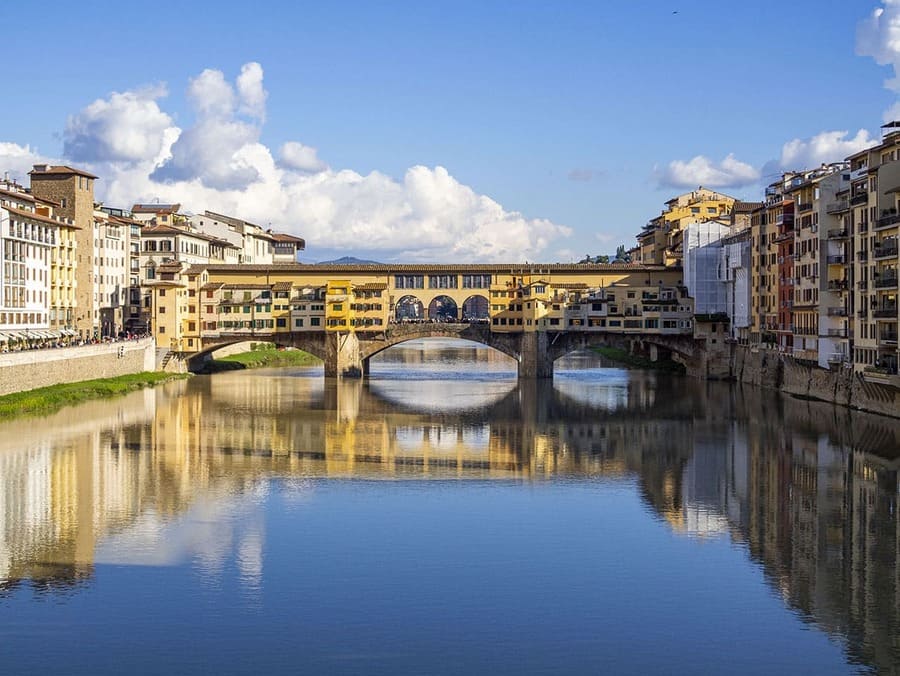Did you know that for me, one of the most fascinating areas in Florence is actually the area of the Arno River and the bridges that connect both sides of the city?
This is because Florence, as we know it today, would never exist without the Arno River.
In fact, the direct access to water was absolutely necessary for the development of the profitable textile industry in the Middle Ages. The textile industry played a major role in the economic development of medieval Florence and made possible the construction of all the amazing monuments we admire today.
During the 12th and 13th centuries Florence started to grow thanks to the textile industry and the city started to develop also on the other side of the river, where the Oltrarno neighbourhood is located today. This is why, starting from the 13th century onwards, the city began investing in the construction of new bridges that would connect the town with its southern part.
The history of the bridges in Florence reveals some of the most important elements of the city’s history. The bridges tell the story of trade, wool production, and also they remind us of the many floods the people of Florence had to face. At the same time the bridges are linked with the history of the Medici family, who influenced development of the city during the Renaissance.
How many bridges in Florence?
Today, the two banks of the Arno River in Florence are connected by 11 different bridges. Some of them are very modern and were built during the 20th century, like the Ponte all’Indiano. However, six of these 11 bridges connect both sides of the Arno River in the historical center of Florence.
These are:
- Ponte Vespucci,
- Ponte alla Carraia,
- Ponte Santa Trinita,
- Ponte Vecchio,
- Ponte alle Grazie,
- Ponte San Niccolò.
Let me guide you through the fascinating stories whispered by the Florence bridges.
What are the Florence bridges?
Bridge in Florence: Ponte Alla Carraia
Ponte Alla Carraia was originally called Ponte Nuovo, meaning the “new bridge”, or Ponte alla Carra, the bridge of the carriages. Its first wooden construction was built during the 13th century and was used by carriages transporting bales of wool across the city.
Unfortunately, the main enemy of the Florentine bridges were the floods, and this 13th-century Florence bridge was damaged and had to be rebuilt after the flood of 1269.
Also this second wooden bridge, however, collapsed. It happened in 1304, in rather particular circumstances, when a large crowd of Florentines gathered on the bridge to watch a performance organised on the river. In 1333 the city decided to invest in a stone bridge located in the same place, hoping it would be more resistant, but yet another flood destroyed also this stone construction.
After the flood of 1557 the bridge was modernized and rebuilt by the brilliant Renaissance architect Bartolomeo Ammannati, who worked under the service of Cosimo I, the Duke of Florence.
The bridge was enlarged during the 19th century but it was completely destroyed by the Nazis in August 1944.
This painful part of Florence’s history occurred when the German troops, evacuating from the city, destroyed all bridges except for Ponte Vecchio. By the destruction of the Florentine bridges, the Nazis wanted to slow down the progress of the Allied forces. After the war, Ponte alla Carraia was rebuilt and reopened in 1951.
Bridge in Florence: Ponte Santa Trinita
Another beautiful bridge in Florence is Ponte Santa Trinita, one of the oldest and most iconic bridges in Florence, alongside Ponte Vecchio.
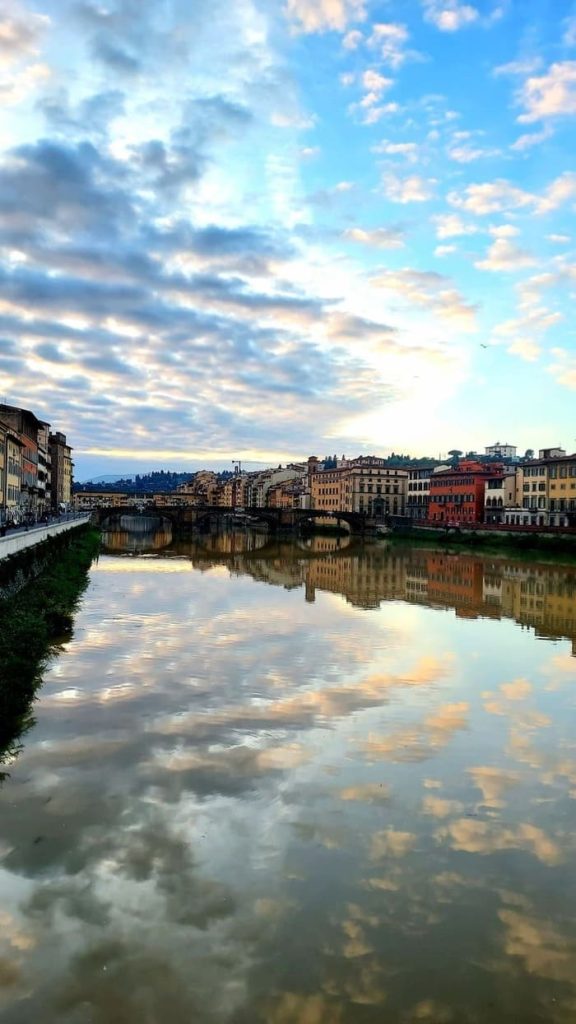
The first bridge at this spot was built in 1251 by the Frescobaldi family, who owned the palace just across the river. This bridge was designed to connect the palace with the city center. Like other bridges of Florence, also Ponte Santa Trinita didn’t resist the floods that inundated Florence in 1296, 1333, and 1557. After the last flood, the one happened on September 13 1557, Cosimo I commissioned Bartolomeo Ammannati for a new Renaissance bridge to be designed here.
Ammannati’s design won the hearts of Florentines, and the bridge became an iconic part of the cityscape with its elliptical arches and marble tiles.
Ponte Santa Trinita played an important role in celebrations of the Medici family’s wedding. In 1608, Cosimo II and Maria Magdalena of Austria walked across the bridge on their arrival to Florence as newly weds. The bridge was decorated on the occasion with statues of the four seasons placed at its both ends. Like the other bridges in Florence, also Ponte Santa Trinita was destroyed in 1944 by the Nazis.
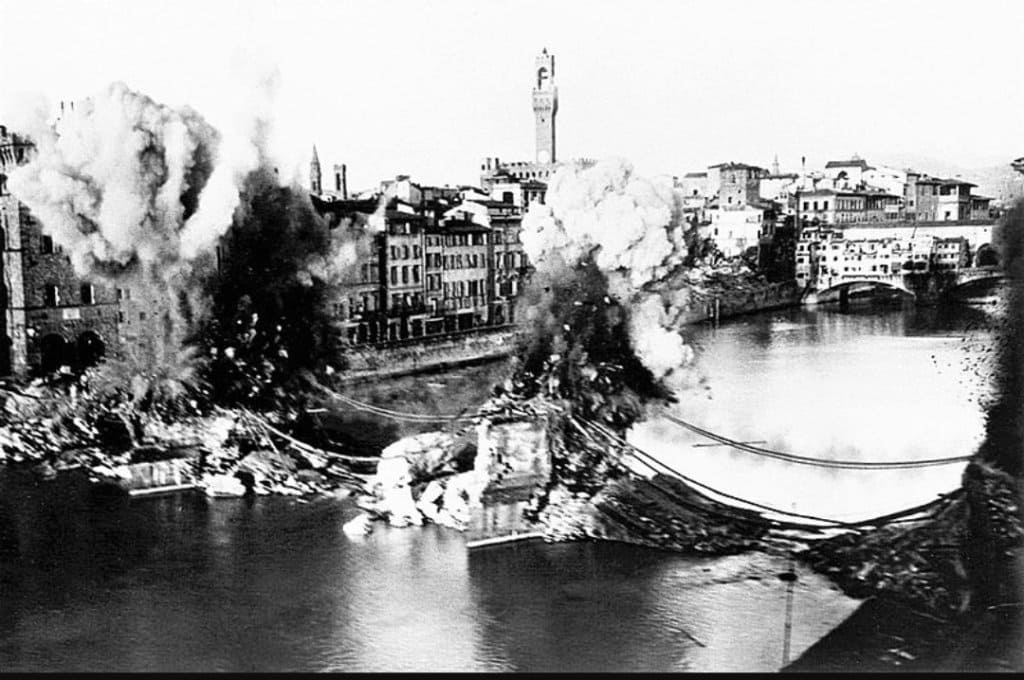
After the war, it was rebuilt according to its original design and reopened in 1958.
Famous bridge in Florence: Ponte Vecchio
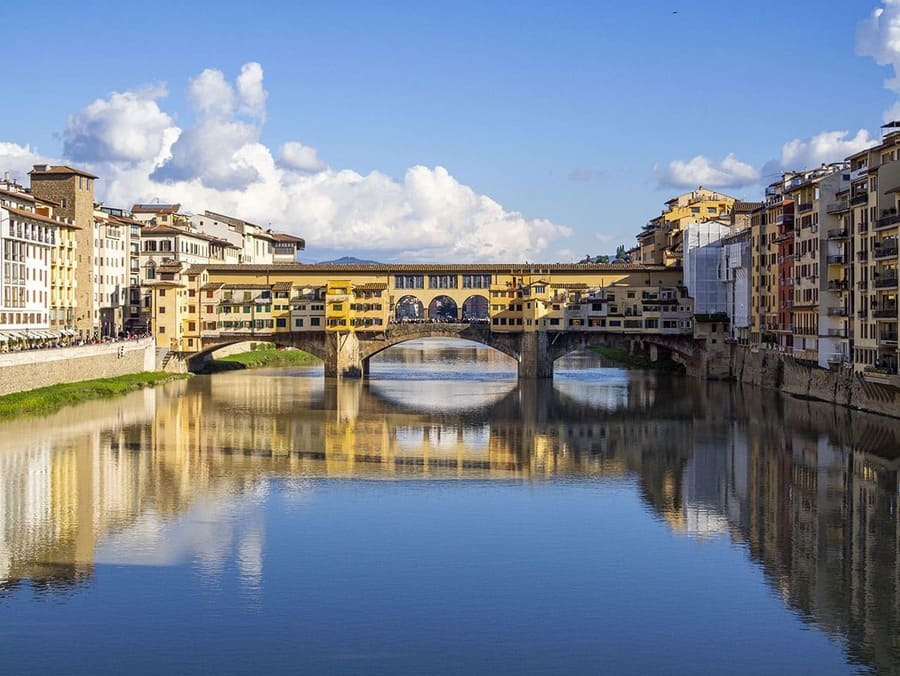
Ponte Vecchio, the oldest and most famous bridge in Florence, stands out as the only bridge in Florence that survived World War II.
Already during the Roman times a wooden bridge stood more or less at the same location as today’s Ponte Vecchio.
The bridge we see today was constructed in the 1340s as a replacement for a previous bridge destroyed by the 1333 flood. It became a market bridge, and shops on it were originally occupied by butchers and fishmongers. The decision to house these shops on the bridge was made for sanitary reasons – the butchers could dispose of unsold meat directly into the river, avoiding the risk of contagion in the city.
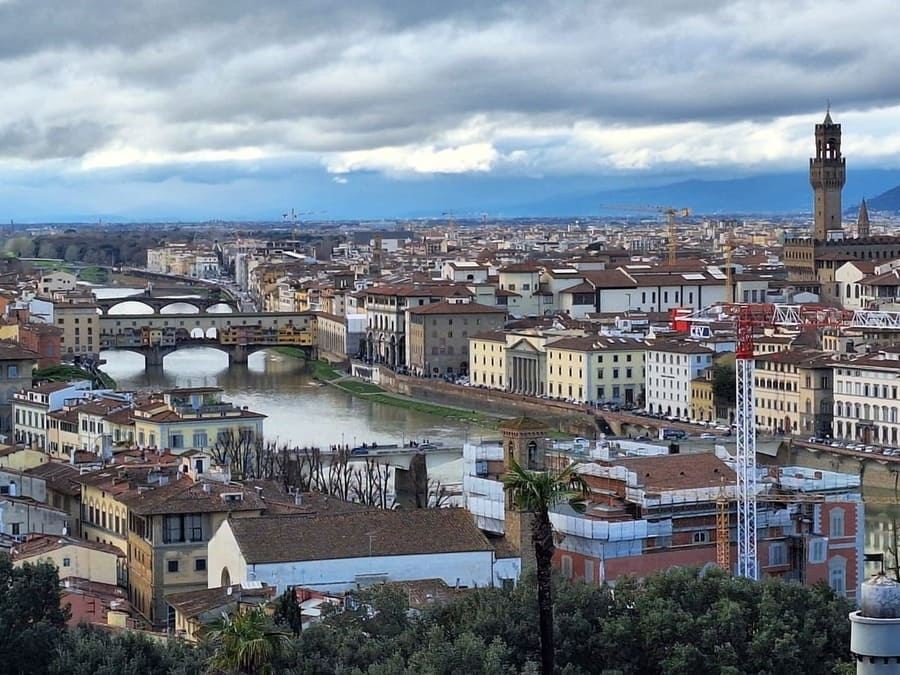
In 1565, the Medici family built the Vasari Corridor running above the shops on Ponte Vecchio. The corridor was a private passageway that connected the Medici’s offices at today’s Uffizi Gallery with their private residence at the Pitti Palace. Because the ducal family started being bothered by the smell of the meat from the shops, during the 1590s, those were given to the goldsmiths. This is why today, Ponte Vecchio is known for its jewelry shops.
The Germans, evacuating from Florence in 1944, destroyed all the bridges but spared Ponte Vecchio. They isolated the bridge from the city, mined it and escaped to the north. Luckily the bridge survived the war.
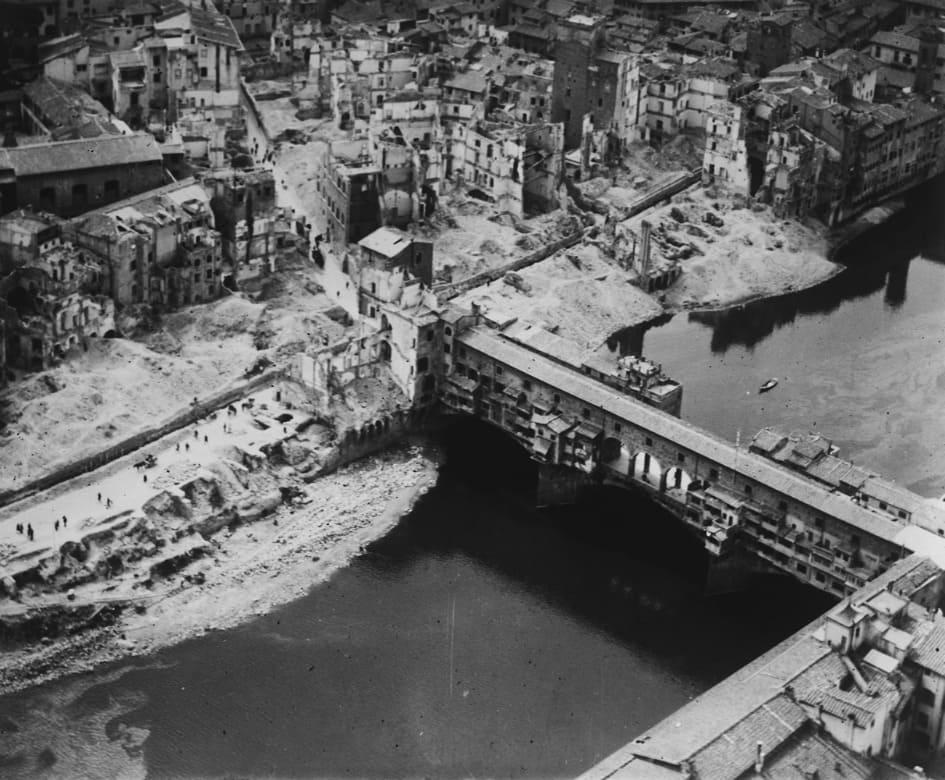
Bridge in Florence: Ponte alle Grazie
Ponte alle Grazie was built in 1237 by the Podestà of Florence, Rubaconte da Mandello. It connected the Santa Croce neighbourhood with the Oltrarno. Unlike other bridges in Florence, Ponte alle Grazie survived many floods, including the disastrous floods of 1333 and 1557.
Over the centuries, the bridge hosted several small structures, such as houses, chapels, and dormitories similar to those on Ponte Vecchio. One of the most famous chapels was dedicated to Santa Maria delle Grazie and this is why the bridge is called Ponte alle Grazie.
In the early 15th century, the bridge also housed cells for cloistered nuns called Le Murate who lived walled up in the small houses on the bridge. By 1424 the nuns were relocated to the nunnery in via Ghibellina, where the Murate Art Centre is located today. Unfortunately in 1876 the houses on the bridge were demolished to make more room for road traffic, and the bridge lost its original character.
Ponte alle Grazie was destroyed in 1944 during World War II.
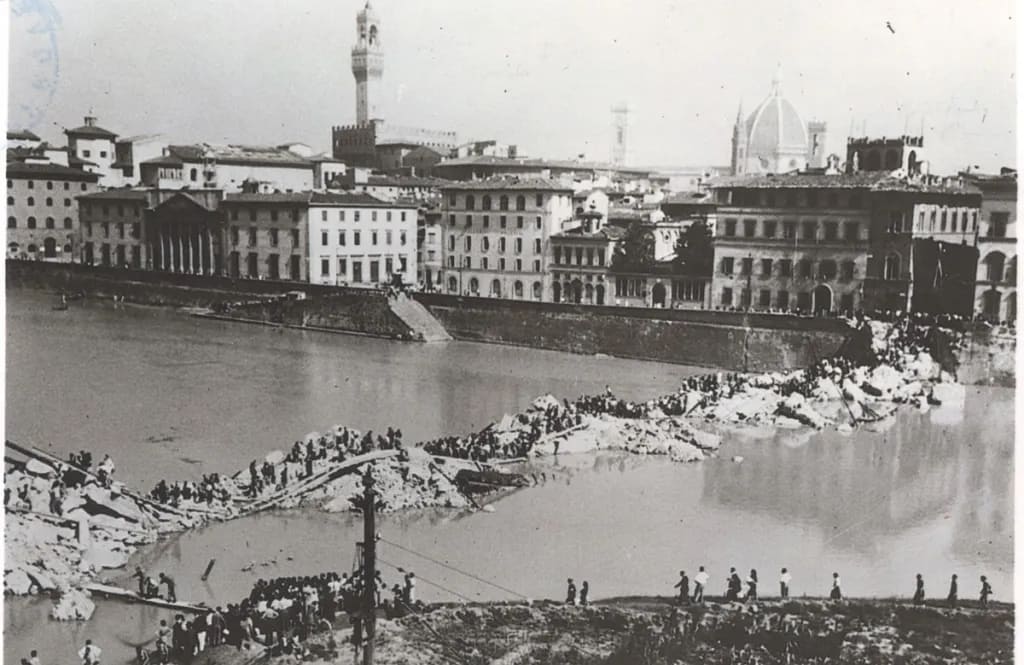
It was rebuilt after the war and is now adorned with a unique and joyful statue of Common Man, created by the Florentine street artist Abraham Clet. This sculpture symbolizes trust, joy, and belief in the positive outcome of one’s projects and dreams.
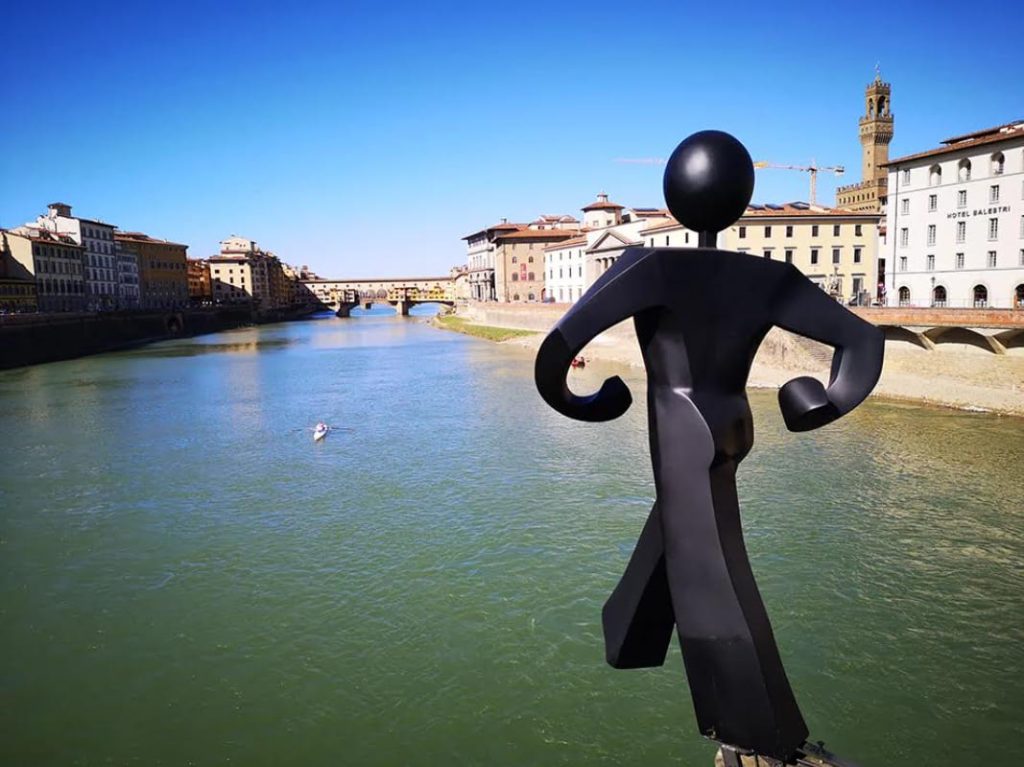
What is the oldest bridge in Florence?
The oldest bridge in Florence is Ponte Vecchio.
It is a historical symbol of the city, with a history that dates back to Roman times. Though the bridge we see today was built in the 14th century, its roots are deeply embedded in Florence’s early history.
Over the centuries, it has witnessed countless events and changes, making it an integral part of the city’s cultural and architectural identity. Its unique structure, with shops built along it, adds to its charm and historical significance.
The most famous bridge in Florence
The most famous bridge in Florence is also Ponte Vecchio. Known for its iconic jewelry shops, the bridge stands as one of the most recognizable landmarks in the city.
Ponte Vecchio’s fame stems not only from its visual appeal but also from its rich history, which includes its survival during World War II when it was the only bridge to remain standing after the German troops destroyed all the others.
This enduring bridge has become synonymous with Florence itself, with its unique shops and rich historical backdrop making it one of the city’s top attractions.
Florence bridges: 4 bridges not to be missed in Florence
Florence bridges are not just functional structures but key pieces of the city’s rich history and stunning architecture.
Among the must-see bridges is Ponte Vecchio, the oldest and most famous of them all. Known for its unique layout with jewelry shops lining both sides, it has survived floods, wars, and centuries of history, making it a symbol of Florence itself.
Just as iconic is Ponte Santa Trinita, with its elegant elliptical arches designed by Renaissance architect Bartolomeo Ammannati. This bridge holds a special place in the hearts of Florentines who decided to rebuid it after World War II in its original, Renaissance form.
Another unmissable bridge is Ponte alla Carraia, which dated back to the 13th century and, despite suffering numerous floods, has been rebuilt and modernized over the centuries.
Ponte alle Grazie offers a glimpse into the city’s medieval past, with the stories of its ancient chapels and nuns’ cells.
Each of these bridges in Florence tells a unique story of Florence’s evolution, making them essential stops for anyone wanting to explore the city’s fascinating history from a different point of view.
Visiting Florence? Don’t just see it – experience it.
Book a guided tour and uncover the stories hidden behind every bridge.
Contact us! We are happy to organize your visit.


